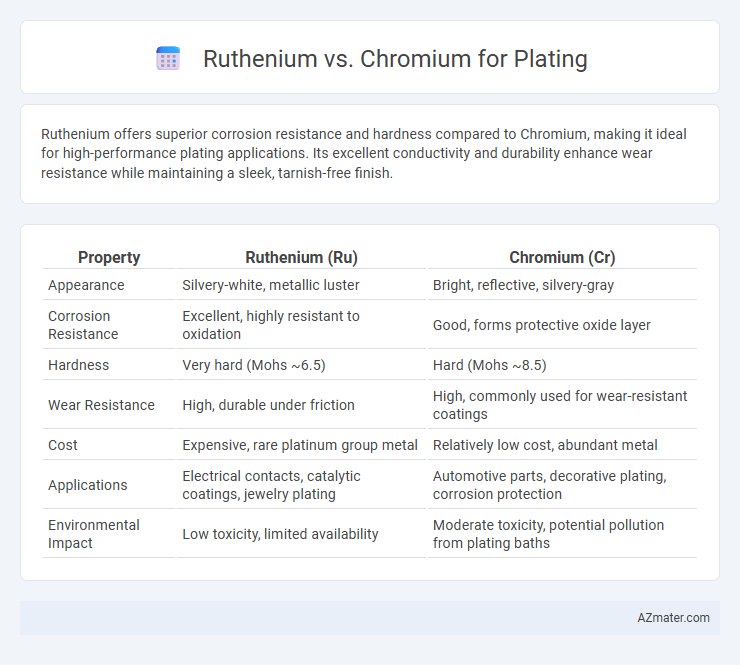Ruthenium offers superior corrosion resistance and hardness compared to Chromium, making it ideal for high-performance plating applications. Its excellent conductivity and durability enhance wear resistance while maintaining a sleek, tarnish-free finish.
Table of Comparison
| Property | Ruthenium (Ru) | Chromium (Cr) |
|---|---|---|
| Appearance | Silvery-white, metallic luster | Bright, reflective, silvery-gray |
| Corrosion Resistance | Excellent, highly resistant to oxidation | Good, forms protective oxide layer |
| Hardness | Very hard (Mohs ~6.5) | Hard (Mohs ~8.5) |
| Wear Resistance | High, durable under friction | High, commonly used for wear-resistant coatings |
| Cost | Expensive, rare platinum group metal | Relatively low cost, abundant metal |
| Applications | Electrical contacts, catalytic coatings, jewelry plating | Automotive parts, decorative plating, corrosion protection |
| Environmental Impact | Low toxicity, limited availability | Moderate toxicity, potential pollution from plating baths |
Overview of Ruthenium and Chromium Plating
Ruthenium plating offers superior corrosion resistance, enhanced hardness, and excellent wear properties compared to chromium, making it ideal for high-performance applications in electronics and automotive industries. Chromium plating is widely used for its cost-effectiveness, decorative appeal, and good corrosion protection on metals like steel and aluminum. Both metals serve distinct purposes: ruthenium excels in durability and conductivity, while chromium remains popular for decorative finishes and moderate corrosion resistance.
Chemical and Physical Properties Comparison
Ruthenium offers superior corrosion resistance and higher hardness compared to chromium, making it ideal for durable and wear-resistant plating applications. Chromium provides excellent oxidation resistance and a bright, reflective finish but is more prone to forming brittle deposits under certain conditions. The chemical inertness of ruthenium enhances its stability in harsh environments, while chromium's higher electrical conductivity supports its use in decorative and functional coatings.
Durability and Wear Resistance Analysis
Ruthenium plating exhibits exceptional durability and wear resistance due to its high hardness and corrosion resistance, making it ideal for applications requiring long-lasting protection against abrasion. Chromium plating offers good wear resistance and corrosion protection but tends to be more susceptible to chipping and cracking under extreme mechanical stress. Ruthenium's superior hardness and resistance to oxidation provide enhanced lifespan and performance in harsh environments compared to traditional chromium plating.
Corrosion Resistance: Ruthenium vs Chromium
Ruthenium offers superior corrosion resistance compared to chromium, maintaining stability in harsh chemical environments such as acids and alkaline solutions. Chromium plating, while effective against oxidation and wear, is more prone to corrosion over time, especially in chloride-rich environments. Ruthenium's enhanced durability and resistance to pitting make it a preferred choice for applications requiring long-term corrosion protection.
Aesthetic Qualities and Surface Finish
Ruthenium plating offers a superior aesthetic with its dark, gunmetal gray to black finish, providing a modern and sophisticated look often favored in high-end jewelry and electronics. Chromium plating delivers a bright, mirror-like shine that enhances visual appeal through its reflective metallic luster, making it popular for automotive trim and household fixtures. Both metals produce smooth, durable surfaces, but ruthenium's unique coloration and hardness contribute to a distinct, scratch-resistant decorative finish compared to chromium's traditional brilliance.
Environmental and Health Considerations
Ruthenium plating offers significant environmental advantages over chromium, as it is less toxic and does not involve hexavalent chromium compounds, which are highly carcinogenic and environmentally hazardous. Chromium plating often requires strict regulatory compliance due to the release of hazardous waste and airborne contaminants, posing health risks such as respiratory issues and skin irritation. Ruthenium, a rare and inert metal, reduces exposure to harmful substances, making it a safer alternative for both workers and the ecosystem.
Cost Effectiveness and Market Availability
Ruthenium plating offers superior corrosion resistance and a distinctive lustrous finish but comes at a significantly higher cost due to its rarity and complex extraction process. Chromium plating is more cost-effective and widely available, with extensive industrial applications benefiting from its affordability and established supply chains. Market availability heavily favors chromium, as ruthenium's limited production restricts large-scale usage despite its premium properties.
Industrial Applications and Use Cases
Ruthenium plating offers superior corrosion resistance and hardness compared to chromium, making it ideal for electronics, jewelry, and automotive components where durability and conductivity are critical. Chromium plating remains widely used in decorative and automotive industries due to its cost-effectiveness and excellent wear resistance, especially on steel and aluminum surfaces. Industrial applications prioritize ruthenium for specialized electronic contacts and hard coatings, while chromium dominates large-scale metal part finishing and aesthetic applications.
Plating Processes and Techniques
Ruthenium plating offers superior corrosion resistance and hardness compared to chromium, making it ideal for high-durability applications in electronics and jewelry. Typical ruthenium plating processes involve electrochemical deposition using complex ruthenium salt solutions, requiring precise control of pH and temperature to achieve uniform thin coatings. In contrast, chromium plating employs hexavalent or trivalent chromium baths with emphasis on thickness control and environmental safety, favoring decorative and industrial hard plating with well-established cathodic reduction methods.
Selecting the Best Plating Material
Ruthenium plating offers superior corrosion resistance and hardness compared to chromium, making it ideal for high-wear applications and electronics due to its excellent conductivity and durability. Chromium plating provides a more cost-effective solution with good corrosion resistance and a bright, reflective finish, commonly used in automotive and decorative applications. Selecting the best plating material depends on application-specific requirements such as environmental exposure, mechanical stress, and budget constraints, with ruthenium favored for precision and durability and chromium chosen for aesthetics and affordability.

Infographic: Ruthenium vs Chromium for Plating
 azmater.com
azmater.com